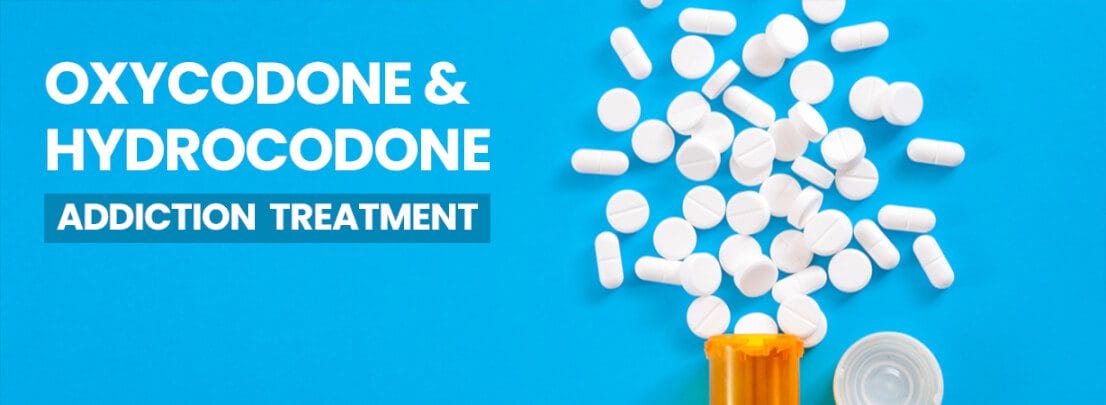Oxycodone & Hydrocodone Treatment
Oxycodone, Hydrocodone, and Fentanyl Addiction Treatment Center
"The Standard of Excellence in the Comprehensive Successful Treatment of Oxycodone and Hydrocodone Addiction."
The reality is addiction to legal substances is just as much an issue in this country as addiction to illegal substances. In fact, addiction to legal painkillers is a far more serious problem in terms of overdose deaths.
U.S. deaths from overdoses of cocaine totaled 14,666 in 2018, according to a new report from the Centers for Disease Control and Prevention. The rate of overdose deaths remained stable from 2009 through 2013, the report found, but then headed upward at about 27 percent each year from 2013 through 2018. Approximately 80% of overdose deaths involved opioids, and three of four opioid overdose deaths involved illicitly manufactured fentanyl (IMFs).
The supply of fentanyl and overdose deaths involving synthetic opioids are projected to have increased for the seventh straight year in 2019. Fentanyl, heroin, cocaine, or methamphetamine (alone or in combination) were involved in nearly 85% of overdose deaths. The CDC report suggests the combination of drugs complicates intervention and treatment efforts; one-half of these deaths involved two or more of these four drugs.
That rate increase represents about 2½ times more cocaine-related deaths in 2018 than in 2014. A Washington Post report indicates that the Drug Enforcement Administration has said increased availability of the drug is “in large part due to record levels of coca cultivation and cocaine production in Colombia.”
Oxycodone (sometimes known by the brand name OxyContin) and Hydrocodone (Lortab) are two of the most popular prescription opioid painkillers.
While these medications are enormously effective at treating pain, they’re also highly habit-forming. Anyone who has struggled with addiction to oxycodone or hydrocodone, or who has a friend or family member who has struggled with addiction to oxycodone or hydrocodone, knows that quitting these drugs isn’t easy.
At Inspire Malibu, we’ve helped many people overcome fentanyl addiction to prescription painkillers with our evidence-based treatment and exceptionally high staff-to-client ratio (we never house more than 11 clients at a time).

How Does Oxycodone and Hydrocodone Affect the Body?
Oxycodone and hydrocodone, as well as any other opiate, work by binding to proteins called opiate receptors that are located in the spinal cord, brainstem, and limbic system (a network of nerves in the areas of the brain responsible for basic emotions such as fear and pleasure).
There are 3 types of opioid receptors, all named after letters in the Greek alphabet: mu, delta, and kappa.
The effects opioids produce when they bind to those receptors is what makes these drugs such an effective treatment for pain management.
Mu receptors in particular are responsible for the intense euphoria users often feel when they take opioids, and they’re also what make opiates so addictive.
Another problem with mu receptors is that they produce the side effect of respiratory depression. Opiates and opioids make it more difficult to breath, and in high enough doses can shut down breathing completely – this is the exact cause of most prescription opioid deaths.
Additional side effects of opioid use include nausea, constipation, itchiness, drowsiness, and a warming sensation throughout the body.
Oxycodone and Hydrocodone Withdrawal
Quitting oxycodone or hydrocodone is difficult enough on its own, and it’s made even more difficult by the effects of withdrawal, which range from mildly unpleasant to truly dreadful.
Common opioid withdrawal symptoms include:
- Common cold symptoms (runny nose, sneezing, fatigue, general achiness, etc.)
- Anxiety
- Depression
- Insomnia
- Cold sweats
- Cramps
- Diarrhea
- Vomiting
- Fever
Inspire Malibu provides a comfortable environment for detoxification, supervised by trained addiction experts.
We use Suboxone and Subutex to curb cravings and make the transition from heavy opioid use to sobriety as painless as possible. Suboxone has been shown to be highly effective in this regard, and it’s much more convenient than going to a Methadone clinic every day.
Non 12 Step, Evidence Based Approach to Treatment
We use a science and evidence-based approach to treatment that includes one on one counseling, group therapy sessions, yoga and other therapies such as the following:
Cognitive and Motivational Enhancement Therapy: Addicts are usually aware that their habit is destroying their health, their careers, and their relationships with family and friends. And yet, despite being aware of these consequences, they still abuse their substance of choice. Our counselors use techniques to help clients stay strong and prevent themselves from relapsing once they leave our treatment facility.
Dialectical Behavior Therapy: The word dialectical in this context is defined as “concerned with or acting through opposing forces”. To Recover From Oxycodone, Hydrocodone or Fentanyl Addiction, Our Clients Must Accept Two Seemingly Contradictory States Of Mind: They Must Accept Who They Are, And They Must Also Seek Change.
Neurofeedback Therapy: This treatment, through the use of an electroencephalography machine, allows our counselors to actually see a client’s brain activity in real-time. This helps the counselor guide the conversation during a session to being as productive as possible at addressing the root causes behind a client’s addiction. Neurofeedback is available for an extra fee unless covered by insurance.
Keeping up with a healthy diet and regular exercise after treatment also helps our clients prevent a relapse down the road.